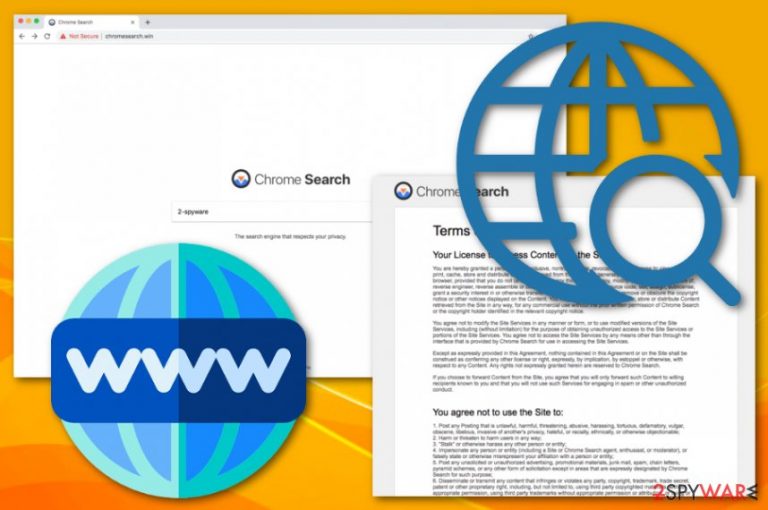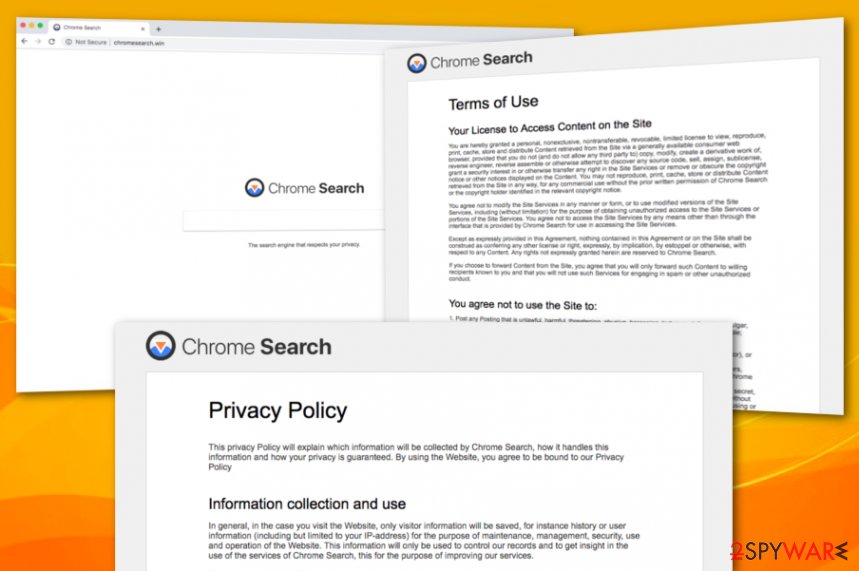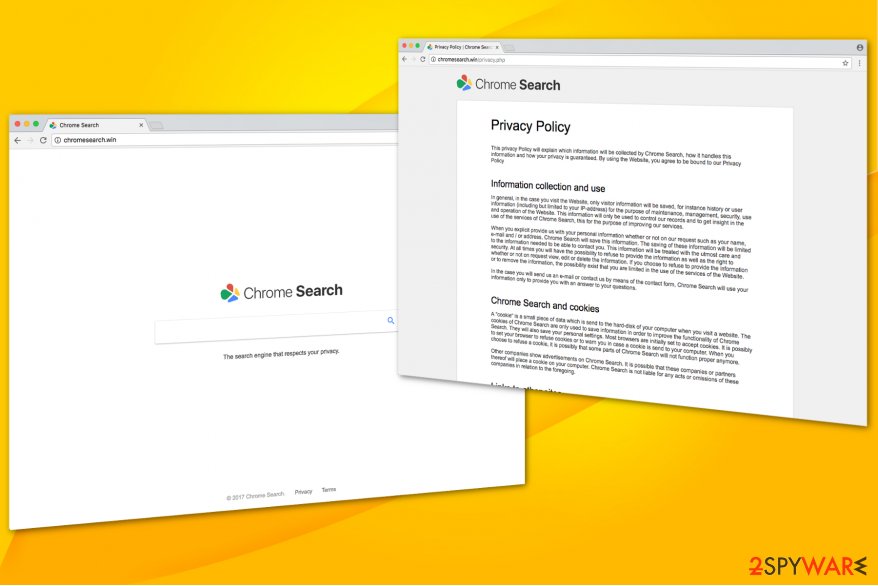Chromesearch.win virus (Removal Guide) - Aug 2019 update
Chromesearch.win virus Removal Guide
What is Chromesearch.win virus?
ChromeSearch.win – a bogus search engine that lies about respecting the user's privacy

Chromesearch.win is a browser hijacker[1] which is presented as a privacy-respecting search engine. Unfortunately, it has been found to act in the opposite way – Chromesearch.win virus starts collecting specific information about the user right after it gets into the system. This data mostly includes browsing-related details such as commonly visited websites, hyperlinks accessed, and so on. However, some potentially unwanted programs are capable of spying on even more private information such as the name, surname, birth date, email address, and residence address of the user.
| Name | ChromeSearch.win |
|---|---|
| Also known as | Chrome Search Win |
| Type | Browser hijacker |
| Category | Potentially unwanted program |
| Activities | Advertising, redirecting, modifying browser settings |
| Danger level | Low. Does not affect the computer system or its components |
| Found in | Software bundles mostly |
| Removal | Use FortectIntego to detect the suspicious app and get rid of it automatically/manually |
Alternatively known as Chrome Search Win, it belongs to a wide group of browser hijackers impersonating Google Chrome. They started reappearing during the last months of 2017 and have been relying on almost identical user interface and features. If you happen to find Chromesearch.today, Clean My Chrome or Cleanserp on your computer, beware that they all belong to a highly questionable developer called Chrome Search.
Once ChromeSearch.win is let into the system, it can initiate these potentially dangerous activities:
- Assigning http://chromesearch.win/ as a default search provider, new tab URL, and start page;
- Blocking the user from resetting the browser parameters to the primary state;
- Using tracking cookies to collect information about user's browsing habits;
- Displaying ads that satisfy user's interests;
- Redirecting the user to third party websites.
As you can see, despite the fact that ChromeSearch.win tracks your online activity and might gather personally identifiable information, it can also cause commercial ads on your favorite websites. These ads are added using a virtual layer that covers the entire website without making modifications on it. Besides, bogus notifications might carry questionable offers of suspicious computer repair products for money swindling purposes.
Beware that such ads caused by ChromeSearch.win can be dangerous as you can hardly know where are they redirecting you to. If you looked at the Privacy Policy of the website, you could find that developers of this search engine fail to take responsibility for the content they display. Thus, after clicking one of these sponsored ads, you may find yourself infected with malware[2].

No matter how trustworthy it seems, we highly recommend you to remove Chromesearch.win from your computer. For that, use professional security software, like FortectIntego. If you are willing to remove this hijacker manually, use a step-by-step guide given at the end of this post. There you will find instructing steps for cleaning web browsers such as Google Chrome, Mozilla Firefox, Internet Explorer, Microsoft Edge, and Safari.
If that is not enough, we should also add that ChromeSearch win describes itself as “the search engine that respects your privacy.” However, the Privacy Policy of this browser hijacker states the opposite:
When you explicit provide us with your personal information whether or not on our request such as your name, e-mail and / or address, Chrome Search will save this information. If you choose to refuse to provide the information or to remove the information, the possibility exist that you are limited in the use of the services of the Website.
There is no question that this deceptive search engine must be avoided. Security experts from France[3] and other countries have already released recommendations to get rid of this hijacker right after it shows up. If you are looking at this search site right now, don't waste your time and initiate Chromesearch.win removal from all of the affected web browsers.

Preventing potentially unwanted programs (PUPs)
It is not a secret that developers are ready to use various techniques to spread their viruses around. One of these methods is bundling their questionable applications together with regular programs to increase the rate of distribution[4]. This way, the benefit from reckless people who do not pay attention to the download/installation process and choose Recommended or Quick settings on the installer.
The permission to install the potentially unwanted program (PUP) is already pre-selected, and only Custom/Advanced options disclose the information about it. Therefore, you should always opt for the latter settings when installing freeware and decline additional applications. Additionally, take notice that automatical protection is not less important than the manual actions you take towards your online safety.
This is why we recommend every user to find a reputable anti-malware tool for their computer systems. Once you pick a particular program, browser the web for information on it, read users' and experts' reviews. Also, make sure that the program as many beneficial features as possible, including safe browsing. Continuously, keep your anti-malware regularly updated for its proper functioning.

Easy steps to remove Chromesearch.win virus
If you are wondering how to remove Chromesearch.win from your computer, you should know that this procedure can be done either automatically or manually. Automatic removal still remains the safest way to uninstall the hijacker as it helps you detect and delete all browser extensions and plug-ins that are related to the Chrome Search. As a result, your computer becomes hijacker-free within several minutes.
However, some people opt for manual Chromesearch.win removal. Thus, we have prepared detailed instructions that should guide you through the termination process. It is vital to follow them carefully since removing incorrect files might cause permanent computer damage. Note that the browser hijacker and all additional content that has been brought by the PUP needs to be eliminated or the suspicious program might easily return.
You may remove virus damage with a help of FortectIntego. SpyHunter 5Combo Cleaner and Malwarebytes are recommended to detect potentially unwanted programs and viruses with all their files and registry entries that are related to them.
Getting rid of Chromesearch.win virus. Follow these steps
Uninstall from Windows
To fix Chrome Search Win redirects on Windows OS, use the guide below. You need to remove all suspicious programs related to this search engine. We also recommend eliminating other unknown apps that showed up on your computer on the same day when your browsers are hijacked.
Instructions for Windows 10/8 machines:
- Enter Control Panel into Windows search box and hit Enter or click on the search result.
- Under Programs, select Uninstall a program.

- From the list, find the entry of the suspicious program.
- Right-click on the application and select Uninstall.
- If User Account Control shows up, click Yes.
- Wait till uninstallation process is complete and click OK.

If you are Windows 7/XP user, proceed with the following instructions:
- Click on Windows Start > Control Panel located on the right pane (if you are Windows XP user, click on Add/Remove Programs).
- In Control Panel, select Programs > Uninstall a program.

- Pick the unwanted application by clicking on it once.
- At the top, click Uninstall/Change.
- In the confirmation prompt, pick Yes.
- Click OK once the removal process is finished.
Delete from macOS
Remove items from Applications folder:
- From the menu bar, select Go > Applications.
- In the Applications folder, look for all related entries.
- Click on the app and drag it to Trash (or right-click and pick Move to Trash)

To fully remove an unwanted app, you need to access Application Support, LaunchAgents, and LaunchDaemons folders and delete relevant files:
- Select Go > Go to Folder.
- Enter /Library/Application Support and click Go or press Enter.
- In the Application Support folder, look for any dubious entries and then delete them.
- Now enter /Library/LaunchAgents and /Library/LaunchDaemons folders the same way and terminate all the related .plist files.

Remove from Mozilla Firefox (FF)
Follow the guide below to learn how to uninstall Chromesearch.win and its components from Mozilla Firefox.
Remove dangerous extensions:
- Open Mozilla Firefox browser and click on the Menu (three horizontal lines at the top-right of the window).
- Select Add-ons.
- In here, select unwanted plugin and click Remove.

Reset the homepage:
- Click three horizontal lines at the top right corner to open the menu.
- Choose Options.
- Under Home options, enter your preferred site that will open every time you newly open the Mozilla Firefox.
Clear cookies and site data:
- Click Menu and pick Settings.
- Go to Privacy & Security section.
- Scroll down to locate Cookies and Site Data.
- Click on Clear Data…
- Select Cookies and Site Data, as well as Cached Web Content and press Clear.

Reset Mozilla Firefox
If clearing the browser as explained above did not help, reset Mozilla Firefox:
- Open Mozilla Firefox browser and click the Menu.
- Go to Help and then choose Troubleshooting Information.

- Under Give Firefox a tune up section, click on Refresh Firefox…
- Once the pop-up shows up, confirm the action by pressing on Refresh Firefox.

Remove from Google Chrome
To get rid of the virus, you need to clean your Google Chrome web browser from adware-related objects such as dubious extensions, plug-ins, and add-ons. Here is some explanation on how to do it.
Delete malicious extensions from Google Chrome:
- Open Google Chrome, click on the Menu (three vertical dots at the top-right corner) and select More tools > Extensions.
- In the newly opened window, you will see all the installed extensions. Uninstall all the suspicious plugins that might be related to the unwanted program by clicking Remove.

Clear cache and web data from Chrome:
- Click on Menu and pick Settings.
- Under Privacy and security, select Clear browsing data.
- Select Browsing history, Cookies and other site data, as well as Cached images and files.
- Click Clear data.

Change your homepage:
- Click menu and choose Settings.
- Look for a suspicious site in the On startup section.
- Click on Open a specific or set of pages and click on three dots to find the Remove option.
Reset Google Chrome:
If the previous methods did not help you, reset Google Chrome to eliminate all the unwanted components:
- Click on Menu and select Settings.
- In the Settings, scroll down and click Advanced.
- Scroll down and locate Reset and clean up section.
- Now click Restore settings to their original defaults.
- Confirm with Reset settings.

Delete from Safari
If some rogue content has managed to find its way to your Safari web browser, you can clean this application by using the below-provided helping lines.
Remove unwanted extensions from Safari:
- Click Safari > Preferences…
- In the new window, pick Extensions.
- Select the unwanted extension and select Uninstall.

Clear cookies and other website data from Safari:
- Click Safari > Clear History…
- From the drop-down menu under Clear, pick all history.
- Confirm with Clear History.

Reset Safari if the above-mentioned steps did not help you:
- Click Safari > Preferences…
- Go to Advanced tab.
- Tick the Show Develop menu in menu bar.
- From the menu bar, click Develop, and then select Empty Caches.

Remove from Microsoft Edge
Delete unwanted extensions from MS Edge:
- Select Menu (three horizontal dots at the top-right of the browser window) and pick Extensions.
- From the list, pick the extension and click on the Gear icon.
- Click on Uninstall at the bottom.

Clear cookies and other browser data:
- Click on the Menu (three horizontal dots at the top-right of the browser window) and select Privacy & security.
- Under Clear browsing data, pick Choose what to clear.
- Select everything (apart from passwords, although you might want to include Media licenses as well, if applicable) and click on Clear.

Restore new tab and homepage settings:
- Click the menu icon and choose Settings.
- Then find On startup section.
- Click Disable if you found any suspicious domain.
Reset MS Edge if the above steps did not work:
- Press on Ctrl + Shift + Esc to open Task Manager.
- Click on More details arrow at the bottom of the window.
- Select Details tab.
- Now scroll down and locate every entry with Microsoft Edge name in it. Right-click on each of them and select End Task to stop MS Edge from running.

If this solution failed to help you, you need to use an advanced Edge reset method. Note that you need to backup your data before proceeding.
- Find the following folder on your computer: C:\\Users\\%username%\\AppData\\Local\\Packages\\Microsoft.MicrosoftEdge_8wekyb3d8bbwe.
- Press Ctrl + A on your keyboard to select all folders.
- Right-click on them and pick Delete

- Now right-click on the Start button and pick Windows PowerShell (Admin).
- When the new window opens, copy and paste the following command, and then press Enter:
Get-AppXPackage -AllUsers -Name Microsoft.MicrosoftEdge | Foreach {Add-AppxPackage -DisableDevelopmentMode -Register “$($_.InstallLocation)\\AppXManifest.xml” -Verbose

Instructions for Chromium-based Edge
Delete extensions from MS Edge (Chromium):
- Open Edge and click select Settings > Extensions.
- Delete unwanted extensions by clicking Remove.

Clear cache and site data:
- Click on Menu and go to Settings.
- Select Privacy, search and services.
- Under Clear browsing data, pick Choose what to clear.
- Under Time range, pick All time.
- Select Clear now.

Reset Chromium-based MS Edge:
- Click on Menu and select Settings.
- On the left side, pick Reset settings.
- Select Restore settings to their default values.
- Confirm with Reset.

After uninstalling this potentially unwanted program (PUP) and fixing each of your web browsers, we recommend you to scan your PC system with a reputable anti-spyware. This will help you to get rid of Chromesearch.win registry traces and will also identify related parasites or possible malware infections on your computer. For that you can use our top-rated malware remover: FortectIntego, SpyHunter 5Combo Cleaner or Malwarebytes.
How to prevent from getting browser hijacker
Access your website securely from any location
When you work on the domain, site, blog, or different project that requires constant management, content creation, or coding, you may need to connect to the server and content management service more often. The best solution for creating a tighter network could be a dedicated/fixed IP address.
If you make your IP address static and set to your device, you can connect to the CMS from any location and do not create any additional issues for the server or network manager that needs to monitor connections and activities. VPN software providers like Private Internet Access can help you with such settings and offer the option to control the online reputation and manage projects easily from any part of the world.
Recover files after data-affecting malware attacks
While much of the data can be accidentally deleted due to various reasons, malware is one of the main culprits that can cause loss of pictures, documents, videos, and other important files. More serious malware infections lead to significant data loss when your documents, system files, and images get encrypted. In particular, ransomware is is a type of malware that focuses on such functions, so your files become useless without an ability to access them.
Even though there is little to no possibility to recover after file-locking threats, some applications have features for data recovery in the system. In some cases, Data Recovery Pro can also help to recover at least some portion of your data after data-locking virus infection or general cyber infection.
- ^ Browser hijacking. Wikipedia. The free encyclopedia.
- ^ Margaret Rouse. Malvertisement. TechTarget. Fuel Your Pipeline Faster.
- ^ LesVirus. LesVirus. Security and Spyware News.
- ^ Stefan Stremersch, Gerard J. Tellis. Strategic Bundling of Products and Prices. Warrington College of Business. Information Technology Support Programs.
